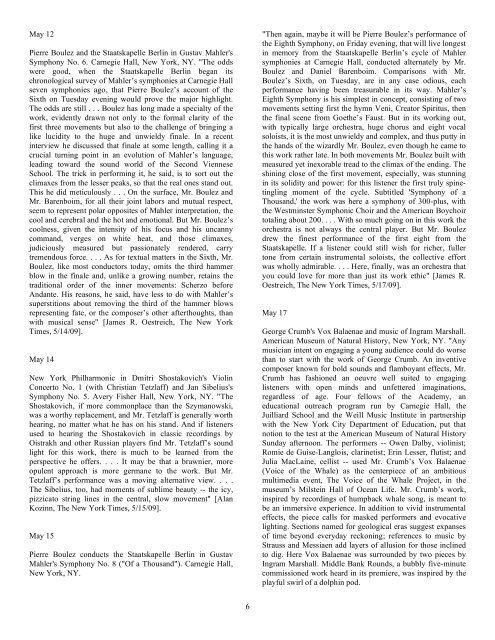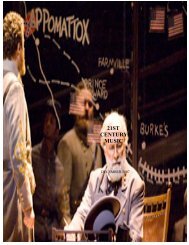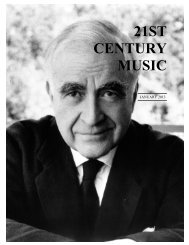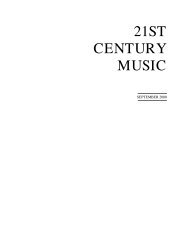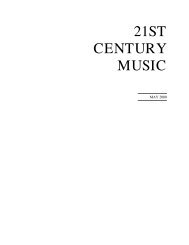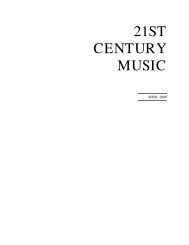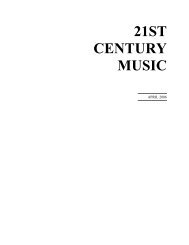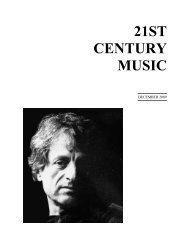Create successful ePaper yourself
Turn your PDF publications into a flip-book with our unique Google optimized e-Paper software.
May 12<br />
Pierre Boulez and the Staatskapelle Berlin in Gustav Mahler's<br />
Symphony No. 6. Carnegie Hall, New York, NY. "The odds<br />
were good, when the Staatskapelle Berlin began its<br />
chronological survey of Mahler’s symphonies at Carnegie Hall<br />
seven symphonies ago, that Pierre Boulez’s account of the<br />
Sixth on Tuesday evening would prove the major highlight.<br />
The odds are still . . . Boulez has long made a specialty of the<br />
work, evidently drawn not only to the formal clarity of the<br />
first three movements but also to the challenge of bringing a<br />
like lucidity to the huge and unwieldy finale. In a recent<br />
interview he discussed that finale at some length, calling it a<br />
crucial turning point in an evolution of Mahler’s language,<br />
leading toward the sound world of the Second Viennese<br />
School. The trick in performing it, he said, is to sort out the<br />
climaxes from the lesser peaks, so that the real ones stand out.<br />
This he did meticulously . . . On the surface, Mr. Boulez and<br />
Mr. Barenboim, for all their joint labors and mutual respect,<br />
seem to represent polar opposites of Mahler interpretation, the<br />
cool and cerebral and the hot and emotional. But Mr. Boulez’s<br />
coolness, given the intensity of his focus and his uncanny<br />
command, verges on white heat, and those climaxes,<br />
judiciously measured but passionately rendered, carry<br />
tremendous force. . . . As for textual matters in the Sixth, Mr.<br />
Boulez, like most conductors today, omits the third hammer<br />
blow in the finale and, unlike a growing number, retains the<br />
traditional order of the inner movements: Scherzo before<br />
Andante. His reasons, he said, have less to do with Mahler’s<br />
superstitions about removing the third of the hammer blows<br />
representing fate, or the composer’s other afterthoughts, than<br />
with musical sense" [James R. Oestreich, The New York<br />
Times, 5/14/09].<br />
May 14<br />
New York Philharmonic in Dmitri Shostakovich's Violin<br />
Concerto No. 1 (with Christian Tetzlaff) and Jan Sibelius's<br />
Symphony No. 5. Avery Fisher Hall, New York, NY. "The<br />
Shostakovich, if more commonplace than the Szymanowski,<br />
was a worthy replacement, and Mr. Tetzlaff is generally worth<br />
hearing, no matter what he has on his stand. And if listeners<br />
used to hearing the Shostakovich in classic recordings by<br />
Oistrakh and other Russian players find Mr. Tetzlaff’s sound<br />
light for this work, there is much to be learned from the<br />
perspective he offers. . . . It may be that a brawnier, more<br />
opulent approach is more germane to the work. But Mr.<br />
Tetzlaff’s performance was a moving alternative view. . . .<br />
The Sibelius, too, had moments of sublime beauty -- the icy,<br />
pizzicato string lines in the central, slow movement" [Alan<br />
Kozinn, The New York Times, 5/15/09].<br />
May 15<br />
Pierre Boulez conducts the Staatskapelle Berlin in Gustav<br />
Mahler's Symphony No. 8 ("Of a Thousand"). Carnegie Hall,<br />
New York, NY.<br />
"Then again, maybe it will be Pierre Boulez’s performance of<br />
the Eighth Symphony, on Friday evening, that will live longest<br />
in memory from the Staatskapelle Berlin’s cycle of Mahler<br />
symphonies at Carnegie Hall, conducted alternately by Mr.<br />
Boulez and Daniel Barenboim. Comparisons with Mr.<br />
Boulez’s Sixth, on Tuesday, are in any case odious, each<br />
performance having been treasurable in its way. Mahler’s<br />
Eighth Symphony is his simplest in concept, consisting of two<br />
movements setting first the hymn Veni, Creator Spiritus, then<br />
the final scene from Goethe’s Faust. But in its working out,<br />
with typically large orchestra, huge chorus and eight vocal<br />
soloists, it is the most unwieldy and complex, and thus putty in<br />
the hands of the wizardly Mr. Boulez, even though he came to<br />
this work rather late. In both movements Mr. Boulez built with<br />
measured yet inexorable tread to the climax of the ending. The<br />
shining close of the first movement, especially, was stunning<br />
in its solidity and power: for this listener the first truly spinetingling<br />
moment of the cycle. Subtitled 'Symphony of a<br />
Thousand,' the work was here a symphony of 300-plus, with<br />
the Westminster Symphonic Choir and the American Boychoir<br />
totaling about 200. . . . With so much going on in this work the<br />
orchestra is not always the central player. But Mr. Boulez<br />
drew the finest performance of the first eight from the<br />
Staatskapelle. If a listener could still wish for richer, fuller<br />
tone from certain instrumental soloists, the collective effort<br />
was wholly admirable. . . . Here, finally, was an orchestra that<br />
you could love for more than just its work ethic" [James R.<br />
Oestreich, The New York Times, 5/17/09].<br />
May 17<br />
George Crumb's Vox Balaenae and music of Ingram Marshall.<br />
American Museum of Natural History, New York, NY. "Any<br />
musician intent on engaging a young audience could do worse<br />
than to start with the work of George Crumb. An inventive<br />
composer known for bold sounds and flamboyant effects, Mr.<br />
Crumb has fashioned an oeuvre well suited to engaging<br />
listeners with open minds and unfettered imaginations,<br />
regardless of age. Four fellows of the Academy, an<br />
educational outreach program run by Carnegie Hall, the<br />
Juilliard School and the Weill <strong>Music</strong> Institute in partnership<br />
with the New York City Department of Education, put that<br />
notion to the test at the American Museum of Natural History<br />
Sunday afternoon. The performers -- Owen Dalby, violinist;<br />
Romie de Guise-Langlois, clarinetist; Erin Lesser, flutist; and<br />
Julia MacLaine, cellist -- used Mr. Crumb’s Vox Balaenae<br />
(Voice of the Whale) as the centerpiece of an ambitious<br />
multimedia event, The Voice of the Whale Project, in the<br />
museum’s Milstein Hall of Ocean Life. Mr. Crumb’s work,<br />
inspired by recordings of humpback whale song, is meant to<br />
be an immersive experience. In addition to vivid instrumental<br />
effects, the piece calls for masked performers and evocative<br />
lighting. Sections named for geological eras suggest expanses<br />
of time beyond everyday reckoning; references to music by<br />
Strauss and Messiaen add layers of allusion for those inclined<br />
to dig. Here Vox Balaenae was surrounded by two pieces by<br />
Ingram Marshall. Middle Bank Rounds, a bubbly five-minute<br />
commissioned work heard in its premiere, was inspired by the<br />
playful swirl of a dolphin pod.<br />
6


